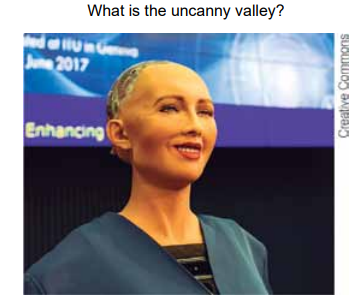Leia o texto sobre o chamado “vale da estranheza” para responder, em português, a questão.

Introduction
The uncanny valley is a term used to describe the relationship between the human-like appearance of a robotic object and the emotional response it evokes. In this phenomenon, people feel a sense of discomfort or even repulsion in response to humanoid robots that are highly realistic.
Androids, avatars, and animations aim for extreme realism but get caught in a disturbing gap named the uncanny valley.
They are extremely realistic and lifelike — but when we examine them, we see they are not quite human. When a robotic or animated characterization lies in this “valley,” people tend to feel a sense of discomfort, strangeness, disgust, or creepiness.
You’ve probably experienced the feeling before — perhaps while watching a computer-generated animated movie or playing a video game. The animated human might look almost real, but that slight difference between looking “almost human” and “fully human” leaves you feeling discomfort or even repulsion.
Implications of the uncanny valley
The uncanny valley has a number of implications in various fields. These include:
• Robotics
As people rely more and more on robotic technology, it is important to design devices that do not create discomfort or distrust. This is particularly true in the development of assistive technologies designed to help people with disabilities perform tasks and interact with their environments. People are more likely to be receptive to designs that are both useful and appealing. Designs that fall into the uncanny valley are likely to be poorly received and utilized less frequently.
• Film
As blockbuster films increasingly rely on computer-generated imagery effects, filmmakers have continued to work toward developing realistic computer-generated animations that blend seamlessly and don’t provoke the uncanny valley.
While many animated films are often criticized for their unrealistic characterizations of the human form, such designs featuring overly large eyes and other dramatically exaggerated features may often be an intentional strategy to avoid the uncanny valley.
• Game Design
The uncanny valley can also have an impact on how players react to realistic characters in video games. In some cases, designers may take advantage of the uncanny valley to create a sense of antipathy or aversion for villainous characters.
(Kendra Cherry. www.verywellmind.com, 14.11.2022. Adaptado.)
a) De acordo com o item “Introduction”, explique o que é “uncanny valley”. Cite duas sensações que podem ser causadas quando as pessoas experimentam o efeito do “vale da estranheza”.
b) De acordo com o item “Introduction”, cite duas situações da vida real que podem fazer com que as pessoas experimentem o efeito do “vale da estranheza”. Por que esse efeito pode acontecer?
a) “O vale da estranheza” é um termo usado para descrever a relação entre a aparência humana de um objeto robótico e a resposta emocional que ela evoca. Nesse contexto, as pessoas sentem uma sensação de desconforto ou mesmo repulsa em resposta para os robôs humanoides que são altamente realistas.
b) O efeito do “vale da estranheza” pode ser vivido assistindo a um filme de animação gerado por computador ou jogando videogame. O humano animado pode parecer quase real, porém a ligeira diferença entre “parecer quase humano” e “totalmente humano” traz a sensação de desconforto e repulsa.